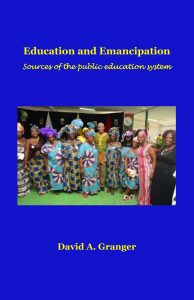A review of four books by David Granger – Education and Transformation: The story of Queen’s College 1844-2019; Education and Emancipation: Sources of the public education system; Teaching teachers: The Cyril Potter College of Education; and, Education and Culture: Teaching in a post-colonial society.
DAVID GRANGER, the President of Guyana, has released another collection of four books. In his latest collection, he examines the transformative role of education and proposes practical measures that would allow education to remain an engine of economic and social change. His collection is an exposition of the role of education in transforming post-colonial societies and in equipping them for the future.

Education and transformation: The story of Queen’s College 1844-2019 celebrates more than a milestone. It links the College’s mission to societal change and transformation.
David Granger attended Queen’s College which, since 1844, has been the country’s premier secondary school and among the crème de la crème of Caribbean high schools. The College celebrated its 175th anniversary in October 2019 and invited the President to give the feature address.
President Granger, addressing the College’s general assembly, situates its development alongside its contributions to the transformation of public education in a post-colonial society. The President provides a thoughtful thesis to account for how the College’s customs, code of conduct and esprit de corps have contributed to its culture of academic excellence.
Interestingly, Granger began not by dwelling on the past but by defining his vision for the College. He addresses the fundamental question to which all long-standing schools inevitably have to respond: how to remain relevant and retain standards of excellence.
The transformation of the country’s public education system, however, did not commence with the establishment of Queen’s College in 1844. It began six years prior with the Emancipation of the formerly enslaved populations of the British West Indies. Education and Emancipation: Sources of the public education system, the second book, traces the evolution of the country’s public education system to the abolition of human enslavement. The enslaved Africans had the foresight to recognise that education was the pathway to a better life for their children.
Granger records the contributions of Africans to education, beginning with the efforts of freed Africans to ensure a better life for their descendants. Granger, addressing the general assembly of the International Decade of People of African Descent – Guyana, President Granger outlines some of his Government’s educational plans in what he calls the Decade of Development 2020-2029. The most significant of which is the restoration of free education at the University of Guyana.
Free education is a lofty goal. The Guyanese President would have been mindful, however, that his country’s attempts at expanding access to education, beginning in 1976, came at huge financial cost to the treasury. This aggravated the country’s economic woes.
Education is pivotal to his Government’s plans for economic and social transformation. In his public utterances, the Guyanese President has articulated his vision for the establishment of an ‘education nation’. He, more than most, will appreciate, however, that the realisation of his proposed ‘education nation’ relies less on political will than it does on the effective delivery of education.
Teaching Teachers: The Cyril Potter College of Education, the third book, highlights the importance which the President has been paying to teacher education. He acknowledges that teachers are the backbone of any educational system and, without trained teachers, the educational system would falter.
His emphasis on training teachers is not misplaced. The Cyril Potter College of Education has been training hundreds of teachers each year to populate the country’s education system.

Granger, as President, has taken steps to improve training and has expressed his expectations about the quality of teachers which the public education system demands. His political instincts caution him against making grandiose promises to teachers but he may well find that, without substantial increases in teachers’ remuneration and benefits, retaining teachers will become a far more daunting task that training them.
Education and Culture: Teaching in a post-colonial society, the final of the four-books, perhaps, is the most insightful of the entire collection. Granger elucidates the often understated link between education and culture. The book’s fundamental argument is that an inclusive education must link education to culture. Guyana is demographically and geographically diverse. The success of educational delivery depends on the degree to which the curricula can be tailored to become more accommodative and respectful of the country’s diversity. The country’s indigenous peoples comprise nine tribes, all of which speak their own tongue, for example.
The Guyanese leader offers sound advice to the designers of the country’s education curricula: the development of a system of inclusive education requires examining the intersection of education and culture. He warns that learners are not all alike, yet the “curricula tend to be same, textbooks tend to be the same and examinations tend to be the same.” Prior to reading this particular book, one may have been tempted to view President Granger as having a utilitarian outlook towards education – delivering the greatest good to the greatest number. The book however makes clear that President Granger ascribes more ambitious goals to education, two of which are reducing inequality and promoting greater inclusivity. The President has a wide and bright vision for education. He argues for greater attention be paid to the intersection of education and culture in the design of education curricula. This four-book collection on education is a must-read for educators, parents and students alike. It reflects a profound mind at work, one which has mined the depths of education’s role in national transformation.



.jpg)








